Planet Technology FPS-5P-M, FPS-2PUWG, FPS-5P-S, FPS-2PUW, FPS-1UA User Manual

Print Server
User’s Manual
Copyright (C) 2004 PLANET Technology Corp. All rights reserved.
The products and programs described in this User’s Manual are licensed products of PLANET Technology, This User’s Manual contains proprietary information protected by copyright, and this User’s Manual and all accompanying hardware, software, and documentation are copyrighted.
No part of this User’s Manual may be copied, photocopied, reproduced, translated, or reduced to any electronic medium or machine-readable form by any means by electronic or mechanical. Including photocopying, recording, or information storage and retrieval systems, for any purpose other than the purchaser's personal use, and without the prior express written permission of PLANET Technology.
Disclaimer
PLANET Technology does not warrant that the hardware will work properly in all environments and applications, and makes no warranty and representation, either implied or expressed, with respect to the quality, performance, merchantability, or fitness for a particular purpose.
PLANET has made every effort to ensure that this User’s Manual is accurate; PLANET disclaims liability for any inaccuracies or omissions that may have occurred.
Information in this User’s Manual is subject to change without notice and does not represent a commitment on the part of PLANET. PLANET assumes no responsibility for any inaccuracies that may be contained in this User’s Manual. PLANET makes no commitment to update or keep current the information in this User’s Manual, and reserves the right to make improvements to this User’s Manual and/or to the products described in this User’s Manual, at any time without notice.
If you find information in this manual that is incorrect, misleading, or incomplete, we would appreciate your comments and suggestions.
CE mark Warning
There are class A and class B device, In a domestic environment, this product may cause radio interference, in which case the user may be required to take adequate measures.
Trademarks
The PLANET logo is a trademark of PLANET Technology. This documentation may refer to numerous hardware and software products by their trade names. In most, if not all cases, these designations are claimed as trademarks or registered trademarks by their respective companies.
Revision
User’s Manual for PLANET Print Server
Model: FPS-5P-S, FPS-5P-M, FPS-1UA, FPS-2PUW, and FPS-2PUWG
Rev: 1.0 (April. 2004)
Part No. EM-PSV8
Page ii

Table of Contents
Chapter 1 Introduction |
1 |
Features ........................................................................................................... |
1 |
Safety Instructions............................................................................................ |
2 |
Package Contents ............................................................................................ |
3 |
Models .............................................................................................................. |
3 |
LED Indicators .................................................................................................. |
8 |
DIP Switch Table ............................................................................................ |
10 |
Diagnostic Push Button .................................................................................. |
10 |
Chapter 2 LAN Installation |
11 |
Procedure ....................................................................................................... |
11 |
Chapter 3 Print Server Configuration |
13 |
Overview......................................................................................................... |
13 |
Other configure method for Print Server ....................................................... |
13 |
Chapter 4 Client PC Configuration |
15 |
Overview......................................................................................................... |
15 |
Wireless Settings for client PCs ..................................................................... |
15 |
Printing Methods............................................................................................. |
16 |
Windows Peer-to-Peer Print Driver ................................................................ |
18 |
Windows SMB Printing................................................................................... |
25 |
Windows with Server-based Print Queues..................................................... |
27 |
Windows using NDPS .................................................................................... |
28 |
Macintosh (AppleTalk).................................................................................... |
29 |
Chapter 5 Bi-Admin Management Utility |
32 |
Requirements ................................................................................................. |
32 |
Installation ...................................................................................................... |
32 |
Operation........................................................................................................ |
33 |
Chapter 6 Web Interface Setup |
40 |
Overview......................................................................................................... |
40 |
Preparation ..................................................................................................... |
40 |
Connecting to the Print Server ....................................................................... |
41 |
Configuration Screens.................................................................................... |
41 |
Chapter 7 Special Features |
51 |
Overview......................................................................................................... |
51 |
Internet Printing Protocol (IPP)....................................................................... |
51 |
Internet Mail Printing ...................................................................................... |
56 |
Printing through the Internet........................................................................... |
60 |
SNMP ............................................................................................................. |
61 |
Wireless Configuration ................................................................................... |
62 |
Chapter 8 Troubleshooting |
67 |
Overview......................................................................................................... |
67 |
Hardware & LAN Problems ............................................................................ |
67 |
AppleTalk (Macintosh).................................................................................... |
68 |
Novell NetWare .............................................................................................. |
71 |
Windows Printing Problems ........................................................................... |
72 |
Appendix A Specifications |
76 |
General Specifications ................................................................................... |
76 |
Protocol Support............................................................................................. |
79 |
Feature Support.............................................................................................. |
79 |
Regulatory Approvals ..................................................................................... |
80 |
Appendix B Network Server Configuration |
81 |
Windows NT Server ....................................................................................... |
81 |
Windows 2000, XP and Server 2003 ............................................................. |
84 |
Novell NetWare .............................................................................................. |
84 |
Unix Systems.................................................................................................. |
89 |
Page ii

Chapter 1 |
1 |
|
|
Introduction |
|
|
This chapter provides an overview of your Print Server's features.
Features
Congratulations on the purchase of your new Print Server. This device was designed to provide a simple and efficient network printing solution. It is packed with features, including:
ØVersatility. The Print Server supports many protocols: TCP/IP, SMB (Service Message Block), Apple EtherTalk, NetBEUI and NetWare (depend on different model). It features one or two Ethernet interface ports and operating system support includes Unix, Novell, and Microsoft Windows.
ØEasy Installation. The Print Server makes adding printers or plotters to your network simple. Depending on your model, it will support 10 Base-T, 100 Base-TX or IEEE802.11b/g. The auto-sensing feature on the connect interface means that there is no need to set jumpers or perform software configuration to select the network interface used.
ØEasy Setup. A number of utility programs are supplied to simplify setup. For Windows 95/98/Me/NT/2000/XP/Server 2003 users, the Bi-Admin program makes it easy to configure the Print Server for a variety of network and server configurations.
ØWeb-based Interface. The Web-based interface provides an easy method of configuration in TCP/IP networks.
ØCompact Size. This allows the Print Server to be used even where space is limited.
ØRemote Management Tools. A variety of software tools are provided. In most environments, both the Print Server and attached Bi-Directional printers can be configured remotely.
ØSNMP Support. The Print Server can act as a SNMP agent, with it own MIB. This allows TCP/IP users to monitor, configure and troubleshoot the Print Server using their existing SNMP management tools.
ØInternet Printing Protocol (IPP) Support. The Print Servers can act as IPP (Internet Printing Protocol) Server, allowing clients, suppliers, colleagues and others to print to your printer from anywhere on the Internet. Windows IPP Client software is also supplied.
See the "Protocol Support" and "Feature Support" tables in Appendix A for details of which models support the different features.
Page 1

Safety Instructions
For your own safety, and to protect your Print Server, please observe the following safety advice.
1.Unplug this device from its power source before cleaning. Use only a slightly dampened cloth for cleaning. Do not use liquid or aerosol cleaners.
2.Avoid using this product near water. Exposure to water poses an electric-shock hazard.
3.Do not place the Print Server on an unstable surface. The device may fall causing serious damage to the device.
4.This device should only be used with the power supply type specified on the marking label. If you are not sure of type of your local power supply, consult your dealer or the local power company.
5.Do not pinch, crimp or otherwise damage the power cord. If exposed to foot traffic, ensures that the cable is properly shielded and does not pose a tripping hazard.
6.If using an extension cord, makes sure the total ampere rating of the products using the cord does not exceed the extension cord's ampere rating.
7.Do not attempt to service this device, as opening or removing casing may expose you to dangerous voltage points or other risks. Refer all servicing to qualified service personnel.
8.The Print Server should be serviced by qualified service personnel under the following conditions:
∙The power cord is damaged or frayed.
∙Liquid has been spilled onto the product.
∙The product has been exposed to rain or water.
∙The product does not operate normally in accordance with the operating instructions.
∙The device has been dropped or the casing has been damaged.
Page 2

Package Contents
You should find the following items packaged with your Print Server. If any items are missing, contact your dealer immediately.
∙The Print Server
∙Power Adapter
∙One CD-ROM containing all support programs, drivers and this manual
∙Quick Install Guide
Models
This manual covers the following Print Server models. Details of the LEDs and DIP Switches are in this Chapter. Further details of each model are contained in Appendix A - Specifications.
FPS-5P-S Fast Print Server
41 Parallel Port
410/100Base-TX
|
|
|
|
|
|
|
|
|
t |
|
|
|
|
|
|
|
|
r |
|
|
|
|
|
|
|
|
o |
|
|
|
|
|
|
|
|
P |
|
|
|
|
|
|
|
|
l |
|
|
|
|
|
|
|
|
e |
|
|
|
|
|
|
|
|
l |
|
|
|
|
|
|
|
|
|
l |
|
|
|
|
|
|
|
|
a |
|
|
|
|
|
|
|
|
r |
|
|
|
|
|
|
|
|
a |
|
|
|
|
|
|
|
|
|
P |
|
|
|
|
|
|
|
|
|
Red Error LED
 Green Status LED
Green Status LED
|
|
|
|
|
|
|
|
|
|
|
|
|
|
|
|
|
|
|
|
|
|
|
12V Power |
|
10/100BaseT Link LED |
|
|||
|
|
|
||
10/100BaseT Connector |
|
|
|
|
DIP Switches
Page 3
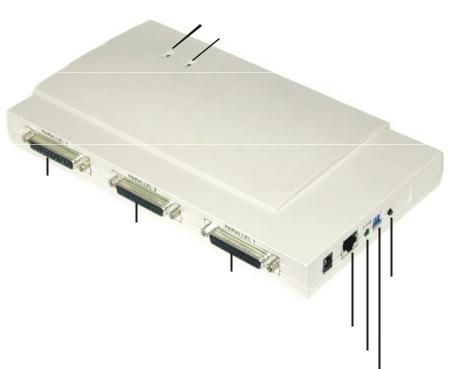
FPS-5P-M Fast Print Server
43 Parallel Ports
410/100Base-TX
Red Error LED
Green Status LED
Parallel
Port 3
Parallel
Port 2
Parallel |
|
Reset Button |
Port 1 |
|
|
|
|
|
12V Power |
|
|
10/100BaseT Connector |
|
|
10/100BaseT LED |
|
|
DIP Switches |
|
|
Page 4
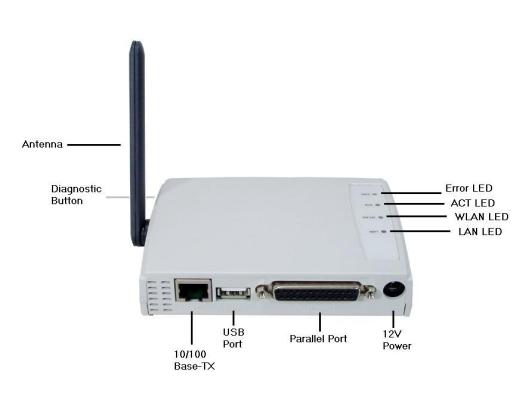
FPS-2PUW Print Server
41 USB Printer Port
41 Parallel Printer Port
4IEEE 802.11b Wireless Station
410/100Base-TX
Page 5
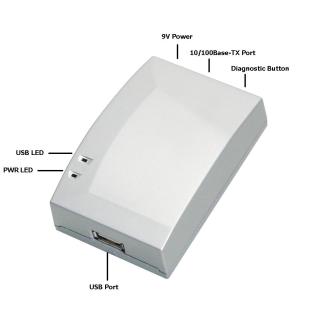
FPS-1UA Print Server
41 USB Printer Port
410/100Base-TX
Page 6
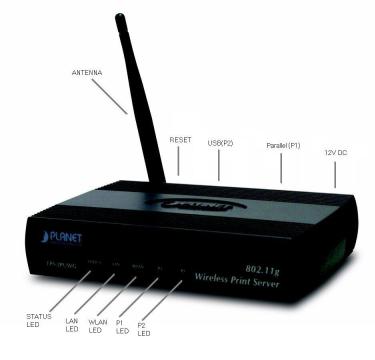
FPS-2PUWG Print Server
41 USB Printer Port
41 Parallel Printer Port
4IEEE 802.11b/g Wireless Station
410/100Base-TX
Page 7

LED Indicators
LEDs - FPS-5P-S, FPS-5P-M
FPS-5P-S and FPS-5P-M have two LED indicators on the top. The Status/Error LED is orange or red. The Power/Link indicator LED is green. The LED indicator modes are described in the following table.
Green LED |
Red/Orange LED |
Status Description |
|
|
|
Off |
Off |
No power. |
|
|
|
On |
On |
Hardware error. |
|
|
|
Flashing |
Flashing |
Firmware upgrade in progress. |
|
|
|
On |
Off |
Normal operation - idle. |
|
|
|
Flashing |
Off |
Normal operation - transmitting or |
|
|
receiving packets from the network. |
|
|
|
LEDs - FPS-2PUW
FPS-2PUW has 4 additional LED indicators as follows:
LED |
Description |
|
|
LAN |
Off - Idle |
|
Flashing - Transmitting or receiving data through the LAN. |
|
|
WLAN |
Off - Idle |
|
Flashing - Transmitting or receiving data through the Wire- |
|
less LAN. |
|
|
ACT |
Off - Printserver is not power on |
|
Flashing - Printserver is working |
|
|
ERR |
Off – Printer is working fine |
|
On - For FPS-2PUW. The printserver is resetting. |
|
|
LEDs - FPS-1UA
FPS-1UA has 2 additional LED indicators as follows:
LED |
Description |
|
|
PWR |
Off - Printserver is not power on |
|
Flashing - Printserver is working |
|
|
USB |
Off – Printer is working fine |
|
Flashing - No printer connected to the USB port |
|
|
Page 8

LEDs - FPS-2PUWG
FPS-2PUWG has 5 additional LED indicators as follows:
LED |
Description |
|
|
||
STATUS |
On - Device power on |
|
|
Off - Device power off |
|
|
|
|
LAN |
On - LAN port is connected |
|
|
Off - LAN port is not connected |
|
|
Flashing - Packets are transmitting or receiving |
|
|
|
|
WLAN |
On - WLAN port is connected |
|
|
Off - WLAN port is not connected |
|
|
Flashing - Packets are transmitting or receiving |
|
|
|
|
P1 |
On - Parallel port is connected |
|
|
Off - Parallel port is not connected |
|
|
Flashing - Packets are transmitting or receiving |
|
|
|
|
P2 |
On - USB port is connected |
|
|
|
|
|
Off - USB port is not connected |
|
|
Flashing - Packets are transmitting or receiving |
|
|
|
|
Page 9

DIP Switch Table
Some models are fitted with DIP switches.
∙The default position for all switches is UP.
∙Normally, there is no need to change the settings of the DIP switches.
∙The purpose of these switches is described in the following tables. Any other possible settings are reserved, and should not be used.
Print Servers (FPS-5P-M, FPS-5P-S)
SW1 |
SW2 |
SW3 |
Description |
|
|
|
|
UP |
- |
- |
Auto select LAN connection (Default) |
|
|
|
Switches 2 and 3 have no effect |
Down |
Down |
Down |
10Base-T - Half Duplex |
|
|
|
|
Down |
Down |
UP |
10Base-T - Full Duplex |
Down |
UP |
Down |
100Base-TX - Half Duplex |
Down |
UP |
UP |
100Base-TX - Full Duplex |
|
|
|
|
Diagnostic Push Button
Print Server FPS-1UA/FPS-2PUW/FPS-2PUWG are fitted with a Diagnostic Push Button. The button is recessed; a pin or paper clip can be used to press it. This button has 2 functions:
∙Restore the factory default settings
∙Print a test page containing all current settings.
To restore the factory default settings:
1.Turn the Print Server OFF.
2.Press and hold the diagnostic button. While pressing the button, switch the Print Server ON.
3.If you continue pressing the button for 10 seconds, a diagnostic page will be printed, showing the new (default) settings.
To generate a Diagnostic print out
1.Ensure that both the Print Server and the printer attached to port 1 are ON.
2.Press the diagnostic button, and hold it in for 2 seconds.
3.The test page, containing the current settings, will be printed.
Note:
PostScript printers are unable to print this page. If you have a PostScript printer on Port 1, the test page will not be printed.
Page 10
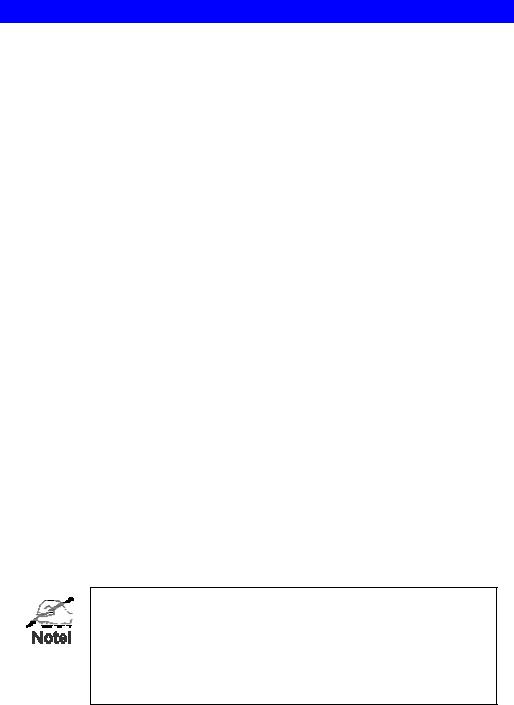
Chapter 2 |
2 |
|
|
LAN Installation |
|
|
This chapter describes how to install the Print Server in your Local Area Network.
Procedure
Before use
∙Make sure the printer you used is not a GDI (Graphical Device Interface) printer. Printserver is not support GDI interface. If connect the GDI printer to printserver, it will work incorrectly. You can refer to the PDF file in GDI Printer folder of the CDROM. There have list some printers that designed with GDI interface. We are afraid the printer is a new one that is not included in this PDF file. So please check to the printer manufacturer for ensure the printer work interface before you buy the printer.
1. Preparation
∙Ensure the power is OFF. Do not connect the Print Server while power is ON.
∙Find the Default Server Name for your Print Server.
The Default Server Name is shown on a sticker on the base of the device. It consists of 8 letters and/or digits as SCxxxxxx. This name also represents its MAC address. For example, SC123456 shows its MAC address as 00-c0-02-12-34-56. Record this name; it may be needed during configuration.
2. Connect the Printer or Printers
Connect the printer or plotter to the Print Server's printer port(s), as appropriate:
∙USB Ports - Use the USB cable supplied with your printer to connect the printer to the Print Server's USB port
∙Parallel Ports - Use standard Parallel port cables to connect the printer to the parallel port on the Print Server. Parallel printer cables should be less than 3 meters long.
3. Connect the Network Cable
∙Connect the network cable to the proper connector on the Print Server. The Print Server will automatically recognize whichever connector is used.
On FPS-2PUW and FPS-2PUWG, connecting the LAN cable will disable the Wireless interface, because the default "Infrastructure mode" wireless setting can NOT be used with the LAN interface.
To use both the LAN and Wireless interfaces, the Wireless mode must be set to "Ad-hoc".
After configuration, the LAN interface can be disconnected if not required.
Page 11

LAN Installation
4. Power Up
Plug in the power adapter cable and power up. Start-up will take only a few seconds.
Use only the Power Supply unit provided with the device. Power
Supply units for different models are not interchangeable.
5. Check the LEDs
For FPS-5P-x
∙The Red Error LED should flash, then turn Off. When the Red LED goes off and the Green LED remains lit or flashes, the Print Server is ready.
∙If your model supports 10Base-T and 100Base-TX, check the 10/100Base-TX link LED or LEDs next to the LAN connection. If the Auto-Negotiation fail, the LED (or both LEDs, if there are 2) will be off. In this case, set the DIP switches to suit your LAN, as described in the DIP Switch Table in Chapter 1.
For FPS-2PUW
∙After plug power adapter to printserver, PWR LED will light on.
∙If printserver has connected to a hub or switch and power on, LAN LED will blink. If the auto-negotiation fails, the LED will be off.
∙If printserver is working with Wireless interface, WLAN LED will be blink.
∙When the printserver is sending data to your printer, the ACT LED will blink.
For FPS-1UA
∙After plug power adapter to printserver, PWR LED will light on.
∙If printserver has connect to hub or switch, PWR LED will start flashing. If the auto-negotiation fails, the LED will keep light on.
∙After printserver connected to LAN. If you don’t connect printer to printserver yet, USB LED will be flashing.
For FPS-2PUWG
∙After plug power adapter to printserver, PWR LED will light on.
∙If printserver has connected to a hub or switch and power on, LAN LED will blink. If the auto-negotiation fails, the LED will be off.
∙If printserver is working with Wireless interface, WLAN LED will be blink.
∙When the printserver is sending data to your printer, the P1/P2 LED will blink.
Page 12

Chapter 3 |
3 |
|
|
Print Server Configuration |
|
|
This chapter provides an overview of the configuration process.
Overview
The Print Server is designed to support many different platforms, and the configuration required would depend upon the environment in which it is installed.
∙When you first time install your printserver to your LAN. We will suggest you install utility “Bi-Admin” to configure your PrintServer in Windows. It can provide an advance and complete configuration for your printserver. See Chapter 5 for details on using Bi-Admin.
∙If you have installed NetBEUI protocol in your network, you don’t need to configure the printserver. You can select NetBEUI protocol in Peer-To-Peer driver installation to let your PC attach to the PrintServer to print, through NetBEUI protocol.
∙PCs wishing to use the printer attached to the Print Server always require configuration. See Chapter 4- Client Configuration for details.
∙If using a NetWare Server (V3, 4, or 5 in "compatibility" mode):
∙For configuration and management, the Bi-Admin program (detailed in Chapter 5 – Bi-Admin Management Utility) is recommended.
∙If using NDPS, refer to Appendix B - Network Server Configuration.
∙If you wish to use a queue-based printing system using Windows NT Server/Windows 2000/XP/Server 2003, the Network Server must be configured as detailed in Appendix B - Network Server Configuration. However, it is not necessary to use a Network Server-based queue; client PCs can print directly to the Print Server by installing the Peer-to-peer Print Driver in Driver/PTP20 folder on the CD-ROM.
∙AppleTalk is also supported, and normally no configuration of the Print Server is required. See the Macintosh section of Chapter 4 for details of client configuration.
Other configure method for Print Server
If you do not have a Windows 32 platform available, use one of the following methods to configure the Print Server.
Web Browser Only available on FPS Series. See Chapter 6 - Web Interface
|
Setup for details. |
FTP |
Using this method, the configuration file is downloaded from the |
|
Print Server, edited, then sent back. No software needs to be in- |
|
stalled. |
|
See the UNIX manual for details. The Unix manual is on the CD- |
|
ROM, in the Manual\Unix folder. |
|
Note: FPS-2PUW, FPS-2PUWG and FPS-1UA do not support |
|
FTP to download the configuration file. |
|
Page 13 |
WPConfig This program requires Windows 3.1, and the IPX/SPX protocol.
This program is on the CD-ROM, in the Utilities\WPConfig folder. Instructions for using the program are in a sub-folder of the Manual folder on the CD-ROM.
PSConfig Menu-based DOS program, intended only to configure the Print Server for use with NetWare V2, 3 and 4.
This program is on the CD-ROM, in the Utilities\DOS folder. Instructions for using the program are in a sub-folder of the Manual folder on the CD-ROM.
Quickset Command-line DOS program, intended only to configure the Print Server for use with NetWare V2, 3 and 4. This program also has a limited ability to configure the NetWare Server itself.
This program is on the CD-ROM, in the Utilities\DOS folder. Instructions for using the program are in a sub-folder of the Manual folder on the CD-ROM.
Page 14

Chapter 4 |
4 |
|
|
Client PC Configuration |
|
|
The chapter details the client configuration required on LAN clients to use the printer or printers attached to the Print Server.
Overview
Before performing client configuration, the following conditions must be met:
∙Print Server must be installed on your network.
∙Print Server must be configured (refer to Chapter 3).
∙Both the Print Server and the attached printer must be powered ON.
∙If the client PC uses a Wireless connection to communicate with the Print Server, the PC's wireless settings must be correct, as described below.
Wireless Settings for client PCs
The FPS-2PUW / FPS-2PUWG incorporate Wireless Stations for IEEE 802.11b/g devices. This section is only relevant to users of the FPS-2PUW and FPS-2PUWG.
To print to the FPS-2PUW or FPS-2PUWG, Wireless stations must ensure that the following Wireless Settings are correct.
|
Ad-hoc Mode |
Infrastructure Mode |
|
|
|
SSID |
Must match the other Wireless sta- |
Must match the Access |
|
tions, unless the SSID is null or |
Point. |
|
"any". |
|
|
If its SSID is null or "any", a Wire- |
|
|
less station can join any Ad-hoc |
|
|
group. |
|
|
|
|
Channel |
Should match the other Wireless |
Access Point sets the |
|
stations. |
Channel used. |
|
However, when joining an existing |
Wireless stations automati- |
|
ad-hoc group, a Wireless station |
cally locate the correct |
|
must use the Channel in use, rather |
channel. |
|
than its own Channel. |
|
WEP Settings |
Must match the other Wireless sta- |
Must match the Access |
|
tions. |
Point. |
|
|
|
To change these settings on your PC, use the software provided with your Wireless card.
If your PC's wireless settings are not correct, you will not be able to print to the FPS2PUW or FPS-2PUWG via the Wireless connection.
Page 15

Printing Methods
The Print Server supports a number of printing methods:
∙Peer-to-Peer Print Driver is installed by running setup.exe in the CD-ROM Driver/PTP20 folder. The print jobs are stored (queued) on your PC, and sent to the Print Server when it is available.
∙Server-based Print Queue means that all print jobs are stored (queued) on the Network Server (e.g. NetWare, Windows NT/2000/XP/Server 2003) and then sent to the Print Server. This allows the Network Administrator to modify the Print Queue. For example, an important job can be moved to the head of the queue.
∙Windows SMB printing is a Microsoft standard for using a "Network Printer". No additional software needs to be installed on your Windows PC, and printing from MS-DOS programs is supported. However, because the Print Server cannot store files, large print jobs may cause problems.
∙AppleTalk is also supported, and normally no configuration of the Print Server is required. See the Macintosh section of this chapter for details of client configuration.
Which printing method should I use?
∙If using Windows 95, 98, Me, NT, 2000, XP or Server 2003, the easiest method is to install the Peer-to-peer Print Driver on the CD-ROM.
∙If using Windows, and you need to print from MS-DOS programs, or you don't wish to install additional software, use SMB. However, SMB is not suitable for large, complex documents, so if you need this as well as MS-DOS printing, you should install BOTH the Peer-to-peer Print Driver and SMB printing. MS-DOS programs can use the SMB printer, Windows programs should use the Peer-to-peer Print Driver.
∙If your LAN has Network Servers (e.g. Windows NT, Windows 2000 Server, Windows XP Server, Windows Serer 2003 and NetWare) use the method advised by your Network Administrator. The Print Server can print via a queue located on a Network server, if desired.
∙Unix users - refer to the Unix Manual on the CD-ROM, in the Manual/Unix directory.
∙Macintosh users - refer to the Macintosh section of this chapter.
Checking your Network Protocols (Windows)
Your PC must have EITHER the TCP/IP or NetBEUI protocols installed.
∙If using the Peer-to-peer Print Driver, the installation program will check this for you.
∙If using Windows SMB Printing, you must check manually, as described below.
(This is for Windows 95 only. All later versions of Windows have TCP/IP installed by default.)
1.Select the Settings - Control Panel - Network option on the Start Menu. You should see a screen like the one following:
Page 16
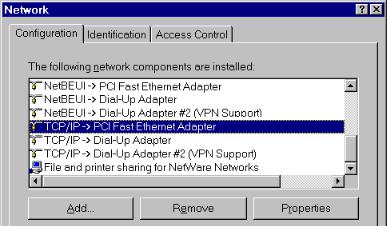
Figure 1: Network Configuration
∙The top line in the list (NetBEUI -> PCI Fast Ethernet Adapter) indicates that the NetBEUI protocol is installed on this PC. Your PC will show the name of the your Network card rather than "PCI Fast Ethernet Adapter".
∙The highlighted line (TCP/IP -> PCI Fast Ethernet Adapter) indicates that TCP/IP is installed. Your PC will show the name of the your Network card rather than "PCI Fast Ethernet Adapter".
2.If neither line is present:
∙Install the NetBEUI protocol by selecting Add - Protocol - Microsoft - NetBEUI - OK. You may be prompted for your Windows CD-ROM.
∙If required, you can also install TCP/IP. However, depending on your LAN environment, TCP/IP may require further configuration.
3.If either protocol is already installed, proceed with installation.
Page 17
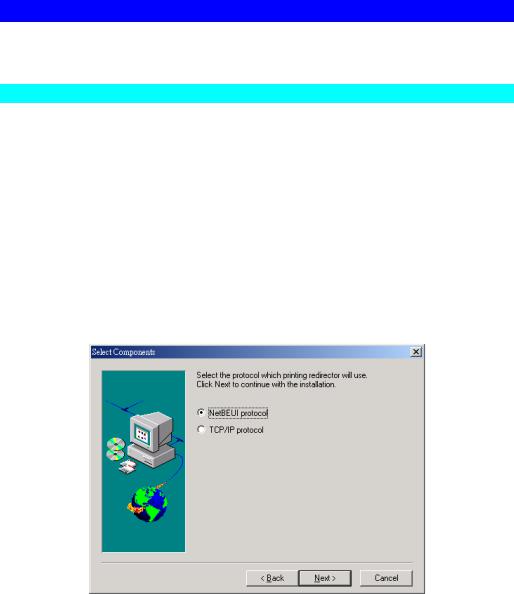
Windows Peer-to-Peer Print Driver
With this printing method, print jobs are stored (queued) on your PC, and then sent to the Print Server when it is available.
Install Peer-To-Peer Print Driver
Before performing the following procedure, the Print Server must be installed on your LAN, and configured as described in Chapter 3. Both the Print Server and the attached printer should be powered ON.
1.Insert the supplied CD-ROM into your drive. Please run SETUP.EXE in Driver\PTP20 folder on CD-ROM by clicking on Start, Run, and enter D:\Driver\PTP20\Setup.exe (where D is the letter of your CD-ROM drive). Click OK.
2.Follow the prompts to complete the installation. (Refer to the Windows section of Chapter 8 - Troubleshooting if there is a problem with the installation.)
3.The Print Driver Setup will then run.
4.When prompt for printing redirector, please select the desired protocol to install and click Next.
5.If select “TCP/IP protocol”, the Select Components window appears. If your computer is the network administrator’s computer and you like to configure the print server’s IP address through easily to use SetBox utility, check “Install SetBox program (System Administrator only). Otherwise, select the default, Install Print Server Driver. Click Next.
Page 18

6.Accept the default Program Folder. Click Next. The Setup windows will appear as the files are copied to your computer.
7.The installation will be stopped in 95% for a few seconds and a screen like the following will be displayed.
∙Click Browse. The Configure screen will search all the Print Server in your LAN.
∙Select the Print Server you want to use in the Print Server list.
Note: You can find the print server’s default name in the back panel as SCxxxxxx. It also represents the print server’s MAC address. For example, SC123456 shows its MAC address: 00-c0-02-12-34-56.
∙If you are using 3 ports Print Server, you can click “Select Device Port” to select the port which your printer connect to.
∙Press “OK” to finish the installation.
Note: If the “Configure PrintServer” screen is not displayed, Press “Alt” + “Tab” to show it.
Figure 2: Printer Port Setup (Peer-to-peer Print Driver)
Page 19
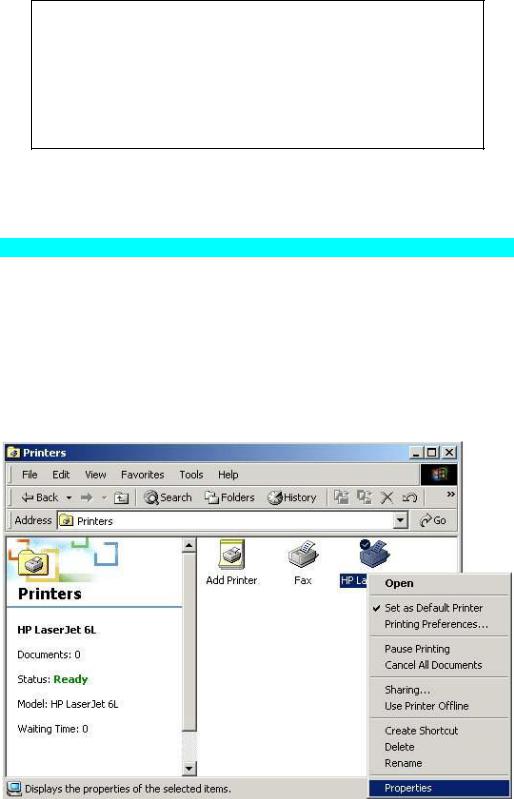
If your Print Server is not listed:
∙Check that both the Print Server and the printer are properly connected, and powered on.
∙Check that the Print Server has been configured.
∙If using TCP/IP, try installing the NetBEUI protocol. See the earlier section Checking your Network Protocols for details. Then uninstall and re-install the Peer-to-peer Print Driver.
8.Now you can find the new printer port when you want to change the printer to other printer port and select the new port to work.
Configure the Printer port
After installing the Peer-to-Peer Print Driver, install the Windows printer driver for each printer(s) attached to the PrintServer.
1.Click on Start => Settings => Printers.
2.If no printers are installed, install the printer driver(s) per the directions from the printer’s manufacturer, as if the printer is a “local” printer attached directly to the PC.
3.After the printer driver has been installed, click on Start => Settings => Printers.
Locate the printer you want to attach to the PrintServer, which appears as an icon in the Printers folder, and right-click on it.
4. Click on Properties.
5. When the Properties window appears,
wFor Windows 95, 98 and Me, choose the Details tab. Click on the Add Port button.
Page 20
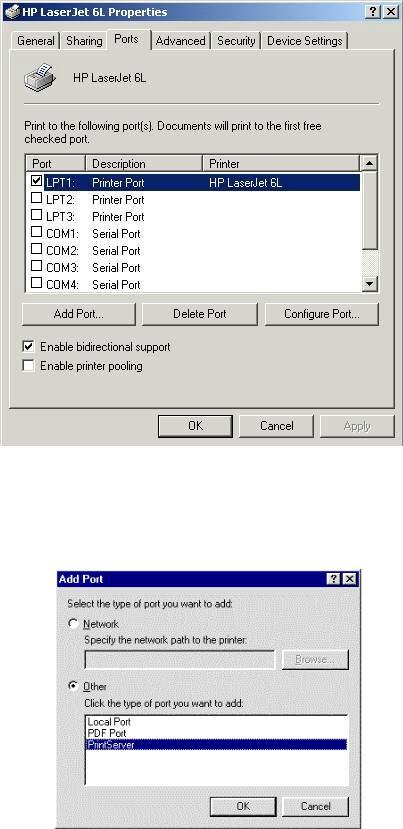
wFor Windows NT, 2000, XP and Server 2003, click on Ports and then Add Port.
6. When the Add Port window appears,
wFor Windows 95, 98 and Me, select Other and then PrintServer under the listed ports to add. Click OK.
wFor Windows NT, 2000, XP and Server 2003, select PrintServer and click on
New Port.
Page 21
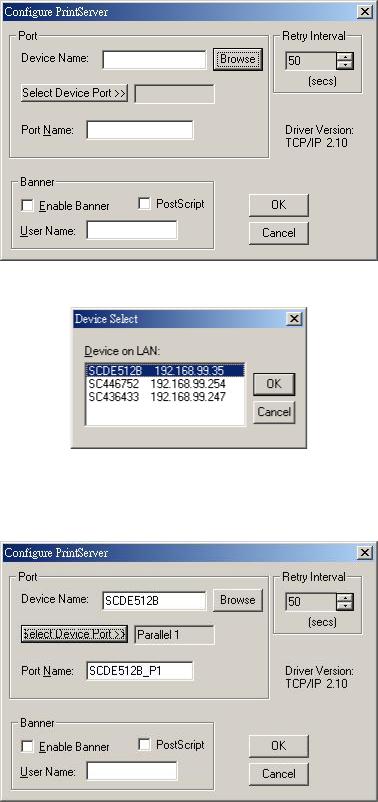
7. The Configure PrintServer window appears, shown below.
8. Click on Browse and choose from the list that appears.
It may take a few seconds for the list to appear. If you have multiple PrintServers on your network, be sure to pick the correct name and click OK.
9. Click on the Select Device Port button.
Page 22
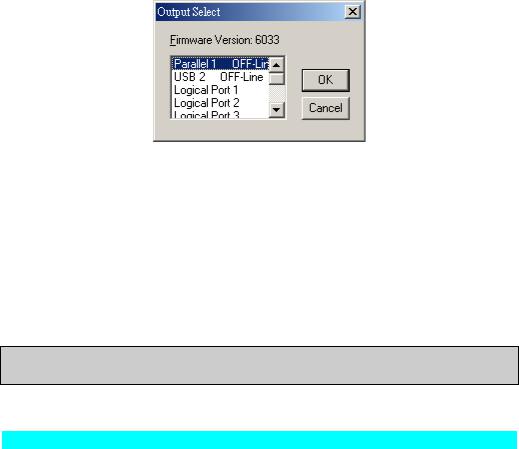
10. If you are using PrintServer with more than one port, choose the PrintServer port connected to the newly installed printer.
11.In the Configure PrintServer window, set the Retry interval, which determines how many seconds, Windows waits before attempting to send a print job again if the PrintServer was busy.
12.If you want each print job to be identified with the user’s name, enable the banner. If you need postscript printing for the banner, select the PostScript option. Be sure
to enter the workgroup or username you want to appear on the banner.
13. When you finish, click OK. When the Printer Properties window reappears, click Apply, then select the General tab. Click on Print Test Page. If the page prints, click OK in the Properties window and close all opened windows. Your PrintServer installation is now complete, and you can print as you do normally.
Note: For Multiple Port PrintServer, you must add a port each time you add a printer to your PrintServer and each time you add an additional PrintServer to your network
Manage the Printing
Management
∙Print jobs can be managed like any Windows printer. Open the Printers folder (Start - Settings - Printers) and double-click any printer to see the current print jobs.
∙If the printer attached to the Print Server is changed, just run this program again, and select the correct printer.
∙To delete a port created by this setup program, use the Windows Delete Port facility:
∙Right-click any printer in the Printers folder, and select Properties.
∙Locate the Delete Port button. This button is on the Details or Ports tab, depending on your version or Windows.
∙If the Print Server's IP Address is changed, and you can no longer print, delete the port (see procedure above) and re-install it.
Port Options
The options for the Peer-to-peer Print Driver are accessed via the Port Settings button.
Page 23
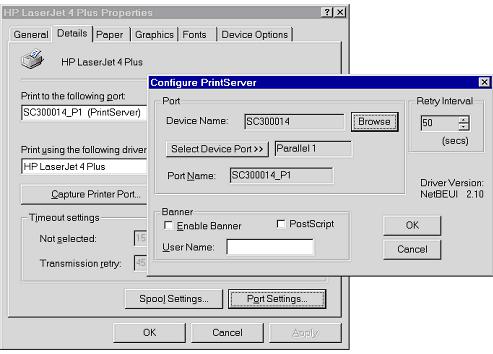
Use Start - Settings - Printers to open the Printers folder, then right-click the Printer, and select Properties. The Port Settings button is on the Details or Ports tab, depending on your version of Windows.
An example screen is shown below:
Figure 3: Port Settings (Peer-to-peer Driver)
Items shown on this screen are as follows:
Port |
If desired, click Browse to select a different Print Server. If the |
|
selected device has multiple ports, the Select Device Port button |
|
can be used to select the port. |
|
The Port Name can not be changed after installation. This name |
|
is shown in the Printer's Properties. |
|
|
Banner |
Check this option to print a banner page before each print job. |
|
∙ If using a PostScript Printer, check the PostScript box. |
|
∙ The User Name will be printed on the banner page. |
|
|
Retry Interval |
Sets how often Windows will poll the Print Server to establish a |
|
connection when the printer is busy. Increase this value if you get |
|
too many warning messages. The least number is 20 seconds. |
|
|
Page 24
